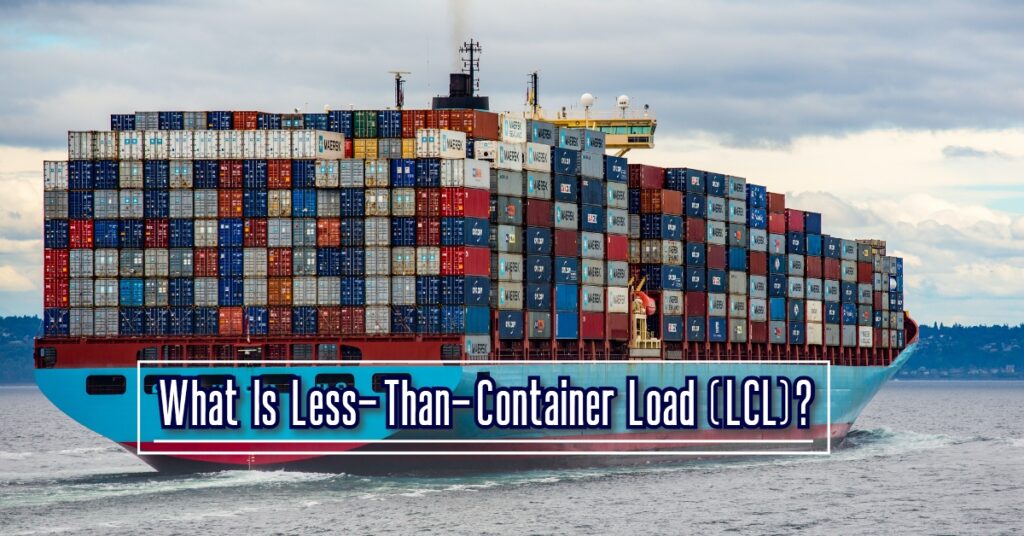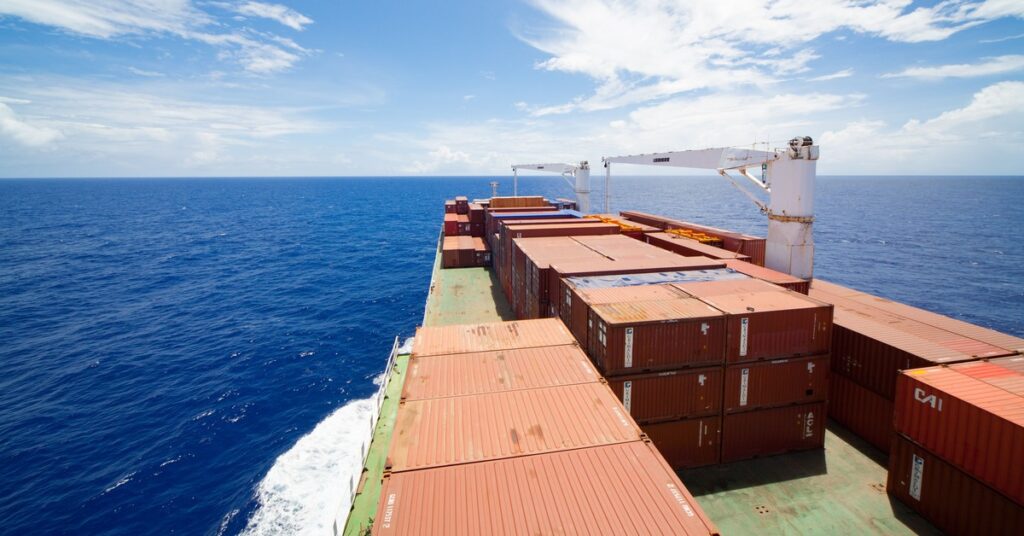Less-than-container load (LCL) is a shipping method that involves filling containers with multiple shipments from different distributors bound for the same destination. If the shipments don’t have sufficient weight or volume to fill an entire standard 20-foot or 40-foot ocean shipping container economically, companies will turn to LCL to transport those smaller loads. LCL plays a crucial role in overseas trade because it helps commercial vessels simplify their shipments and move a higher volume of cargo during each voyage.

The Logistics Behind LCL
Say an entrepreneur wants to send 200 cubic feet of cargo overseas on a commercial vessel. It doesn’t make much financial sense to request a 20 or 40-foot container for a shipment that small, so instead, the entrepreneur decides to partner with other businesses and share a container on the same ship. This scenario is the basic premise of LCL.
Maritime trade companies primarily utilize LCL shipping on their ultra large container vessels designed for long voyages. These vessels typically carry more than 10,000 containers and sometimes reach more than 20,000. However, smaller ship categories such as Panamax and Handymax vessels can also contain LCL cargo.
No matter which ship the company uses, it needs to consolidate LCL cargo into a handful of containers to get as close to full container loads (FCLs) as possible and maximize the ship’s space. This consolidation process is known as “groupage,” and its primary purpose is to group similar items of LCL cargo together rather than randomly throw them in the same carton.
A vessel can be chosen to transport LCL cargo based on a handful of factors:
- Size: UCLVs are the main ships used for LCL cargo because they have more available deck space for stacking containers and a larger hull for containers below deck.
- Weight: The weight of a cargo ship significantly affects its stability and draft — the ship’s depth below the water’s surface. Here, UCLVs are at a disadvantage because they can only enter specific ports and navigate deeper waterways due to their low drafts.
- Hull design: Vessels with wider beams can usually carry more containers than vessels with narrow ones. Similarly, a ship with a deeper hull can take more containers below deck than one with a shallower hull.
- Types of containers: The containers on board can significantly affect a ship’s carrying capacity. For example, refrigerated containers for perishable items are typically thicker and heavier than dry containers, which adds more weight to the vessel and reduces the number of other containers it can carry.
- Other cargo: A ship might also carry vehicles, bulk materials, or heavy machinery that take up precious space and a big chunk of the ship’s carrying capacity.
The LCL grouping process looks similar to the regular preparation of full container loads, but a few key differences hide within the steps. Examine the three main stages of preparing LCL cargo — packaging, labeling and loading.
- Packaging
The first important step in the grouping process is choosing the appropriate packaging. For example, operators often need to group certain food products in the same cartons because they need to stay frozen or refrigerated. Electronics also group together because they’re fragile and need extra protection.
However, filling each container to its optimal capacity is the cargo handler’s top priority, so there is always a small possibility that incompatible items get grouped together. This potential disadvantage makes it all the more important for shipping companies to collaborate with trustworthy and reputable cargo handlers.
Generally, most LCL cargo requires extra packaging because the cartons get handled multiple times and the shipments are packed close together. Operators might add shockproof materials such as packaging cushions, bubble wrap, uline foam or air bubble film along with the typical corrugated cardboard boxes.
The packed cartons are then stacked onto wooden or plastic pallets based on the shipper’s instructions. Pallets make it much easier to move large quantities of items that aren’t shipped in bulk, which includes LCL containers. A standard pallet can hold about one ton or 1.8 cubic meters of cargo.
- Labeling
Next, employees must label each pallet holding LCL containers with specific handling instructions and the destination’s address. For example, certain goods have to remain right side up to avoid damage. The smallest and most fragile items are at the pallet’s top, while the heaviest and most durable items are at the bottom.
Once each pallet is appropriately labeled, employees add a layer of shrink wrap to keep everything stable and prevent leaks from liquid cargo. Then, the pallets make their way to cargo freight stations for final preparations.
Container freight stations are facilities close to serving ports that serve as staging areas before loading the cargo onto vessels or delivering it to customers. These crucial locations handle several tasks depending on the cargo’s volume, including drayage, movement of containers, storage and stacking.
- Loading
Now, the LCL containers are ready for overseas travel, and the only thing left to do is load them onboard and secure them to the ship in tall stacks. These tasks mainly rely on twistlocks that insert into slots in each container’s corner castings, holding the stacked containers together and effectively gluing them to the floor.
Ship employees might also have to tie lashing rods to the bottom layers of each stack for added stability, especially if they’re heading for bad weather or rough waters. Rather than attaching stacks laterally through bridge fittings, each stack stands alone so operators can easily unload them without affecting the other stacks.
Finally, rubber or plastic shipping cones are placed between the containers to prevent them from shifting and sliding during transport. The resulting load resembles a “forest” of independent cargo stacks that sway back and forth with the ship’s movements but always remain secured to the deck surface.
The main principle of load securement is to know the exact weight and dimensions of the cargo, and use the twistlocks and lashing rods accordingly. LCL can make this information easier to obtain because the products aren’t in bulk and often weigh the same pounds per unit, which simplifies the calculation.

Advantages of LCL
The greatest advantage of Less-Than-Container Load is a potentially massive reduction in shipping costs. The prices of overseas freight are typically based on the cargo’s volume rather than a flat rate, so the expenses from LCL shipments are lower because they take up less space than FCL. If the products are small and stackable, then LCL is the obvious choice from a financial perspective.
LCL is also cheaper than air freight — the other primary international trade and transportation method. It incentivizes companies to choose the more economically and environmentally sustainable option of a smaller cargo vessel instead of a commercial plane that guzzles fuel and produces tons of emissions.
Speed and flexibility are other advantages of LCL. During busy trade seasons, when every vessel is traveling at almost full capacity, companies find LCL shipment opportunities more easily than FCL shipment opportunities, thus avoiding costly delays. This benefit is significant in the post-COVID world of frequent supply chain disruptions.
Disadvantages of LCL
Although Less-Than-Container Load gives maritime traders a much-needed alternative to FCL and helps them save on shipping costs, it does have some disadvantages. As previously mentioned, there is always the chance cargo gets grouped with incompatible items. For example, food items can end up in the same container as chemical cleaning supplies and become inedible as a result.
Additionally, loading and unloading LCL containers at import and export destinations increases the shipping time. The more hands that handle the containers, the more likely they are to suffer damage before reaching the buyer. These potential drawbacks make LCL risky for small businesses with highly limited inventories.
Even if a business does everything correctly, items from other distributors inside an LCL container could encounter issues with a country’s customs regulations and cause a major delay. Moreover, the cargo might get damaged if customs officials seize the container and inspect everything inside.
Less-Than-Container Load Fees and Regulations
International shipping regulations are complicated by necessity and LCL is no exception. National and international maritime legislators must account for various factors, including weather conditions, time zone changes, language barriers and different currencies. They also have to follow proper security proofing procedures as they transfer cargo to other containers.
For starters, distributors need to provide the same documentation that’s required for FCL shipments:
- Bill of lading
- Commercial invoice
- Packing list
- Certificate of Origin
- Dangerous cargo certificate, if required
- Insurance certificate
LCL is also subject to fees from various entities, just like any other transportation method. The warehouse that stores the LCL cargo, the cargo freight station and the port facility could all charge an additional fee. All the taxes and tariffs businesses typically pay for commercial exports also apply.
Most dangerous goods are allowed in LCL shipments, but there are substance regulations that could prevent businesses from mixing certain items. For example, flammable substances and matches aren’t a great combination. Additionally, some countries will only accept dangerous items with special written approval.
To avoid legal troubles, comply with all rules and regulations in the LCL’s country of origin and destination. Ignorance is not an excuse for breaking the law, especially in maritime trade, where security threats lurk around every corner.
LCL Makes Maritime Trade Simpler
Less-than-container load is an emerging shipping strategy that has simplified maritime trade in the post-COVID world. While it’s not the best solution for every situation, it can play a vital role in helping companies minimize their expenses and avoid disruptions with full container loads. Look for LCL to become a more widely used practice worldwide in years to come.
Frequently Asked Questions
What is the basic premise of Less-Than-Container Load?
LCL allows multiple businesses to combine their low-volume shipments into the same containers, helping them save time and money. LCL shipments usually include similar items for safety and security reasons.
What types of ships are most often used in LCL shipping?
Ultra large container vessels are still the main ships used in LCL shipping, but smaller vessels like Panamax and Handymax cargo ships are also viable options. It all depends on the ship’s size, weight, hull design and the types of containers and cargo on board.
What are the advantages of LCL?
LCL’s main advantage is lower shipping costs because the shipments are typically smaller. It’s also less expensive than air freight, which is the only other option besides overseas shipping. It can help companies avoid delays during busy trade seasons and maintain a steady pace of exports.
What are the disadvantages of LCL?
LCL increases the chance of damaging the cargo because it gets handled twice as much and might get grouped with incompatible items. Additionally, customs officials might seize the container for reasons unrelated to your products and cause a major delay.
Are there any unique regulations that only apply to LCL shipping?
The only specific regulations that apply to Less-Than-Container Load involve the distribution of dangerous substances. Businesses might be unable to group certain items together if their combination would cause damage or lead to a safety hazard. All the other typical shipping rules and regulations apply to LCL without change.
- The Push to Reduce Cruise Ship Carbon Emissions in 2024 – July 19, 2024
- Marine Satellite Internet: How Ships Keep Connected – July 10, 2024
- What to Wear on a Boat – June 24, 2024




Leave a Reply